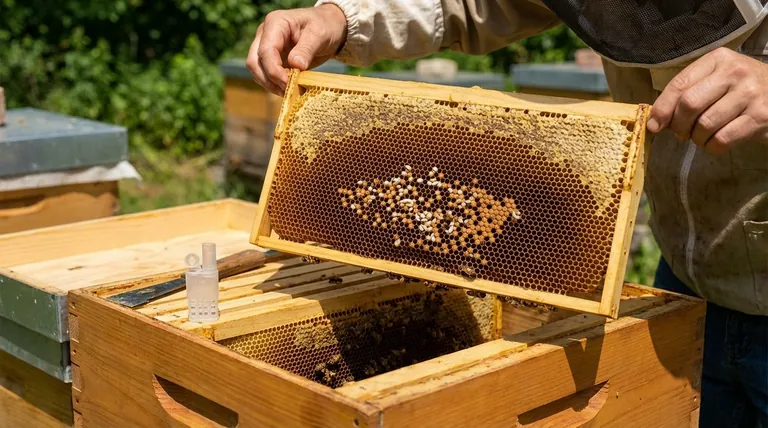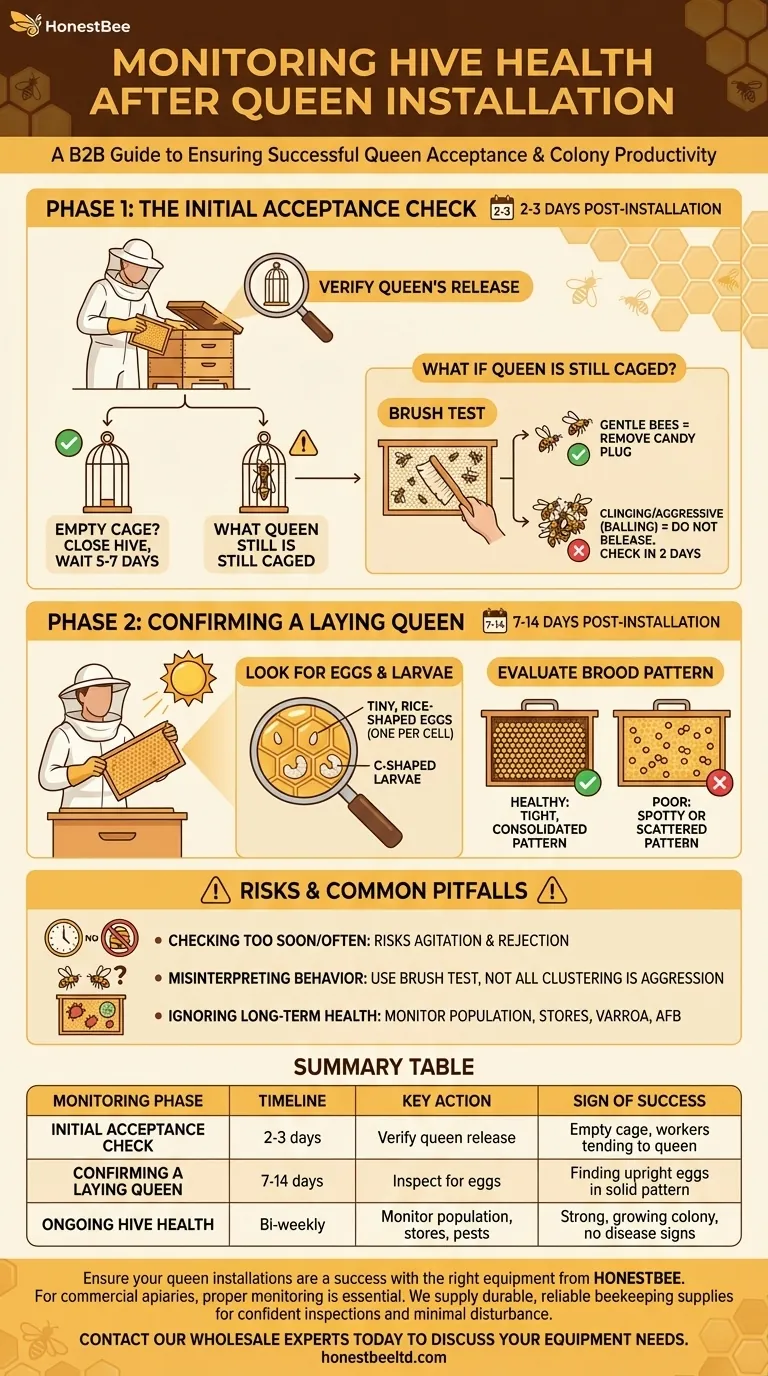To monitor your hive after installing a new queen, your first check should occur two to three days after installation to confirm she has been released from her cage. The ultimate confirmation of success is finding newly laid eggs, which you should look for within one to two weeks. Successful queen acceptance is the critical first step, followed by ongoing monitoring of the colony's overall health and productivity.
The core of post-installation monitoring is a two-step process: first, verify the queen's release and the colony's acceptance, and second, confirm she is laying a healthy brood pattern. Patience is your most important tool, as disturbing the hive too early can cause the colony to reject her.

Phase 1: The Initial Acceptance Check (2-3 Days Post-Installation)
Your first inspection is a brief, low-disturbance check focused on one question: Has the queen been released and accepted? Opening the hive too soon or for too long can stress the colony and jeopardize acceptance.
Verifying the Queen's Release
Gently open the hive and locate the introduction cage you installed. All you need to do is confirm that the cage is empty.
If the queen has been released, close the hive信息up immediately and wait another 5-7 days before your next inspection.
What If the Queen Is Still Caged?
If the queen is still inside her cage, you need to assess the colony's behavior toward her. Do not immediately release her, as the workers may not be ready to accept her.
The most reliable method is the "brush test." Gently brush the worker bees off the screen of the queen cage. If they move away easily, they are likely tending to her and acceptance is near. You can then gently remove the candy plug to expedite her release.
If the bees are clinging tightly, acting aggressively, and trying to sting the cage, they are still hostile. This is called "balling." Do not release her. Close the hive and check again in another two days.
Phase 2: Confirming a Laying Queen (7-14 Days Post-Installation)
This is the most important inspection. Finding eggs is the definitive proof that your new queen has been accepted and is performing her function.
Look for Eggs and Larvae
Carefully and calmly inspect the central frames of the brood nest. Tilt the frame新闻 toward the sun to see into the bottom of the cells.
You are looking for tiny, rice-shaped eggs, one per cell, standing upright in the center. Finding eggs is the ultimate sign of success. You do not need to physically see the queen herself.
If you also see young, c-shaped larvae, that is even better. It confirms the eggs she laid days ago are viable and are being cared for by the workers.
Evaluate the Brood Pattern
A high-quality queen will lay in a tight, consolidated pattern, with few skipped cells. It will look like a solid patch of brood.
A spotty or scattered pattern can be a sign of a poorly-mated or failing queen, even if she was initially accepted. Keep a close eye on this in subsequent inspections.
Understanding the Risks and Common Pitfalls
Successful requeening requires careful timing and minimal interference. Avoid these common mistakes that can lead to queen rejection or failure.
Checking Too Soon or Too Often
The most common error is excessive enthusiasm. Every time you open the hive, you risk agitating the bees. This stress can cause them to turn on a queen they were otherwise beginning to accept.
Misinterpreting Bee Behavior
A cluster of bees on the cage is not always a sign of aggression. They often cluster to feed and tend to the queen. Use the brush test to differentiate between caring and balling.
Ignoring Long-Term Health Indicators
Queen acceptance is not the end of the story. You must continue regular hive inspections to monitor for other critical factors.
Watch for a growing colony population, adequate honey and pollen stores, and signs of pests or diseases like Varroa mites or American Foulbrood (AFB). A healthy queen cannot overcome a colony collapsing from other pressures.
Making the Right Choice for Your Goal
Your approach to monitoring can be adapted based on your experience level and the specific needs of your apiary.
- If your primary focus is minimal disturbance: Perform a single, definitive check 7-10 days after installation, focusing solely on finding eggs.
- If your primary focus is early problem detection: Conduct the brief 2-3 day check to confirm her release, followed by the more thorough egg check at 7-10 days.
- If your primary focus is long-term hive strength: View queen acceptance as the first step, and commit to consistent, bi-weekly inspections to monitor brood patterns, population growth, and overall colony health.
Ultimately, successful queen monitoring balances patient observation with decisive action when necessary.
Summary Table:
| Monitoring Phase | Timeline | Key Action | Sign of Success |
|---|---|---|---|
| Initial Acceptance Check | 2-3 days post-installation | Verify queen release from cage | Empty cage, workers tending to queen |
| Confirming a Laying Queen | 7-14 days post-installation | Inspect brood frames for eggs | Finding upright eggs in a solid brood pattern |
| Ongoing Hive Health | Bi-weekly after confirmation | Monitor population, stores, and pests | Strong, growing colony with no disease signs |
Ensure your queen installations are a success with the right equipment from HONESTBEE.
For commercial apiaries and beekeeping equipment distributors, proper monitoring is essential for maintaining hive strength and productivity. HONESTBEE supplies the durable, reliable beekeeping supplies and equipment you need to conduct inspections with confidence and minimize hive disturbance.
Let us help you build a stronger, more productive apiary. Contact our wholesale experts today to discuss your equipment needs.
Visual Guide

Related Products
- Multi-Function Queen Roller Cage and Catcher
- Professional Multi-Functional Queen Bee Cage
- Durable Galvanized Steel Spring Queen Bee Cage
- Professional Multi-Compartment Queen Cage with Sliding Lid
- Professional Queen Cage with Sliding Gate and Feeder Plug
People Also Ask
- How do you check if the queen has been released after installation? A Guide to Successful Queen Acceptance
- What are the components of a standard queen cage? A Guide to Safe Queen Introduction
- What items are needed to place the queen bee's cage in the hive? A Guide to Successful Queen Introduction
- What are the consequences of an early-emerging virgin queen? Prevent Hive Chaos and Protect Your Queen Line
- What are common problems during queen introduction? Ensure Hive Acceptance and Queen Survival



















